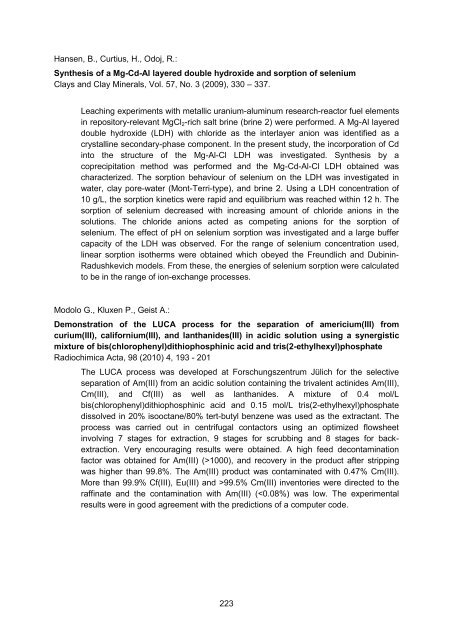Annual Report 2009/2010 - JUWEL - Forschungszentrum Jülich
Annual Report 2009/2010 - JUWEL - Forschungszentrum Jülich
Annual Report 2009/2010 - JUWEL - Forschungszentrum Jülich
You also want an ePaper? Increase the reach of your titles
YUMPU automatically turns print PDFs into web optimized ePapers that Google loves.
Hansen, B., Curtius, H., Odoj, R.:<br />
Synthesis of a Mg-Cd-Al layered double hydroxide and sorption of selenium<br />
Clays and Clay Minerals, Vol. 57, No. 3 (<strong>2009</strong>), 330 – 337.<br />
Leaching experiments with metallic uranium-aluminum research-reactor fuel elements<br />
in repository-relevant MgCl 2 -rich salt brine (brine 2) were performed. A Mg-Al layered<br />
double hydroxide (LDH) with chloride as the interlayer anion was identified as a<br />
crystalline secondary-phase component. In the present study, the incorporation of Cd<br />
into the structure of the Mg-Al-Cl LDH was investigated. Synthesis by a<br />
coprecipitation method was performed and the Mg-Cd-Al-Cl LDH obtained was<br />
characterized. The sorption behaviour of selenium on the LDH was investigated in<br />
water, clay pore-water (Mont-Terri-type), and brine 2. Using a LDH concentration of<br />
10 g/L, the sorption kinetics were rapid and equilibrium was reached within 12 h. The<br />
sorption of selenium decreased with increasing amount of chloride anions in the<br />
solutions. The chloride anions acted as competing anions for the sorption of<br />
selenium. The effect of pH on selenium sorption was investigated and a large buffer<br />
capacity of the LDH was observed. For the range of selenium concentration used,<br />
linear sorption isotherms were obtained which obeyed the Freundlich and Dubinin-<br />
Radushkevich models. From these, the energies of selenium sorption were calculated<br />
to be in the range of ion-exchange processes.<br />
Modolo G., Kluxen P., Geist A.:<br />
Demonstration of the LUCA process for the separation of americium(III) from<br />
curium(III), californium(III), and lanthanides(III) in acidic solution using a synergistic<br />
mixture of bis(chlorophenyl)dithiophosphinic acid and tris(2-ethylhexyl)phosphate<br />
Radiochimica Acta, 98 (<strong>2010</strong>) 4, 193 - 201<br />
The LUCA process was developed at <strong>Forschungszentrum</strong> <strong>Jülich</strong> for the selective<br />
separation of Am(III) from an acidic solution containing the trivalent actinides Am(III),<br />
Cm(III), and Cf(III) as well as lanthanides. A mixture of 0.4 mol/L<br />
bis(chlorophenyl)dithiophosphinic acid and 0.15 mol/L tris(2-ethylhexyl)phosphate<br />
dissolved in 20% isooctane/80% tert-butyl benzene was used as the extractant. The<br />
process was carried out in centrifugal contactors using an optimized flowsheet<br />
involving 7 stages for extraction, 9 stages for scrubbing and 8 stages for backextraction.<br />
Very encouraging results were obtained. A high feed decontamination<br />
factor was obtained for Am(III) (>1000), and recovery in the product after stripping<br />
was higher than 99.8%. The Am(III) product was contaminated with 0.47% Cm(III).<br />
More than 99.9% Cf(III), Eu(III) and >99.5% Cm(III) inventories were directed to the<br />
raffinate and the contamination with Am(III) (
















